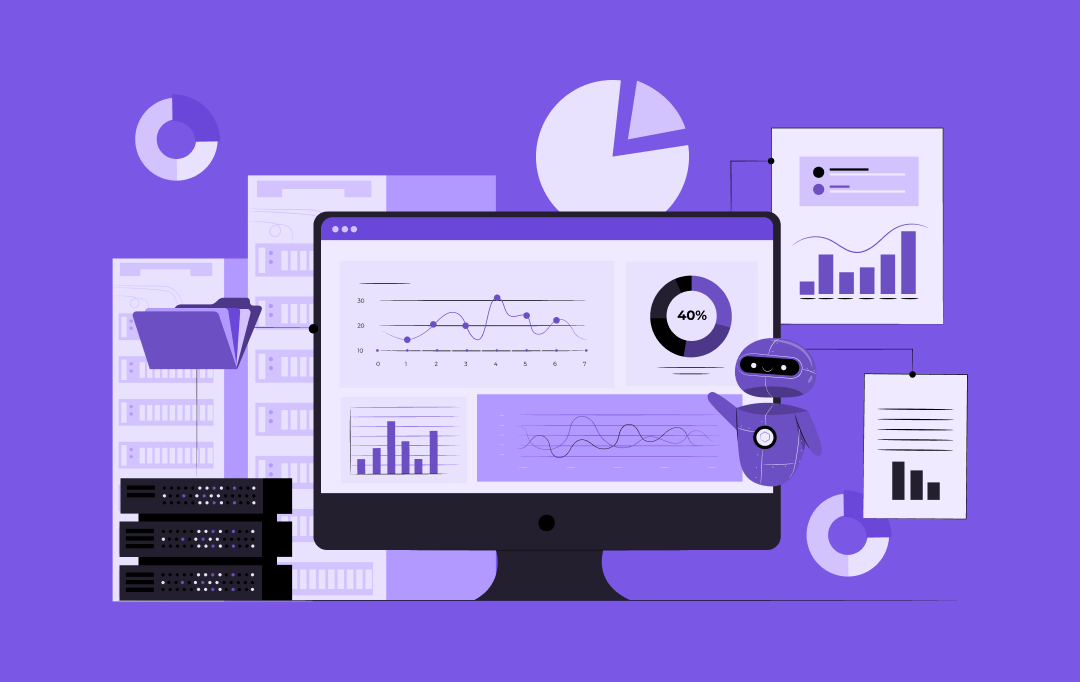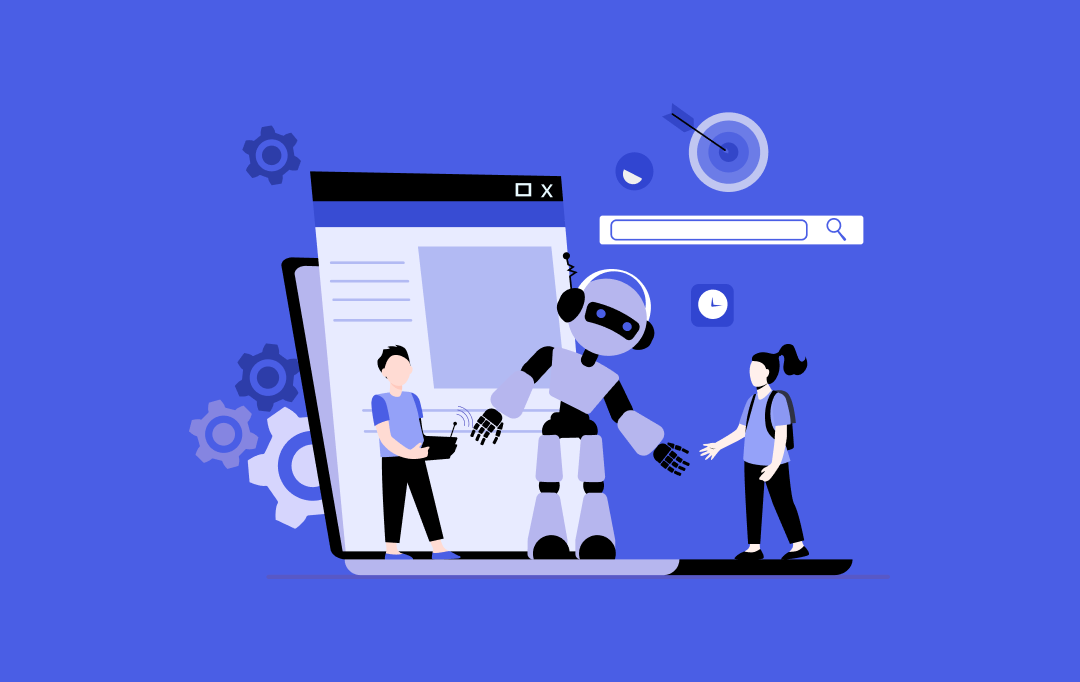- How Artificial Intelligence Works in Drone Technology?
- 1. Perception and Sensor Fusion
- 2. Computer Vision and Object Detection
- 3. Autonomous Navigation and Path Planning
- 4. Decision-Making and Control
- 5. Swarm Intelligence
- 6. Machine Learning and Model Training
- 7. Edge Computing and Real-Time Processing
- Current Challenges in the Drone Industry and How AI Address Them
- 1. Regulatory Compliance
- 2. Safety and Collision Avoidance
- 3. Battery Life and Energy Efficiency
- 4. Data Processing and Analysis
- 5. Autonomous Operation
- 6. Security
- Benefits of Artificial Intelligence in Drones Technology
- 1. Enhanced Autonomy
- 2. Improved Situational Awareness
- 3. Intelligent Navigation and Path Planning
- 4. Real-time Data Analysis and Decision-Making
- 5. Swarm Coordination
- 6. Predictive Maintenance
- 7. Expanded Applications
- Various Applications of Artificial Intelligence in Drones
- 1. Precision Agriculture
- 2. Infrastructure Inspection
- 3. Search and Rescue Operations
- 4. Delivery Services
- 5. Environmental Monitoring
- 6. Security and Surveillance
- 7. Mining and Exploration
- 8. Military and Defence
- How to Implement Artificial Intelligence in Drones?
- 1. Specify Use Cases and Requirements
- 2. Gather and Prepare Data
- 3. Select and Develop Models
- 4. Train and Validate Models
- 5. Hardware Integration
- 6. On-board Processing or Cloud Integration
- 7. Testing and Simulation
- How Does AI in Drones Pose Ethical and Privacy Concerns?
- Privacy Invasion
- Data Security Risks
- Unfair Discrimination
- Accountability
- Autonomy and Control
- Future of AI-powered Drones
- Human-Drone Symbiosis
- Cross-Domain Applications
- Edge AI and 5G Integration
- Ethical AI and Responsible Deployment
- Advanced Sensor Fusion and Multimodal Perception
- How Can Appinventiv Help You Navigate the AI-Driven Drone Revolution
- FAQs
The integration of Artificial Intelligence (AI) with drone technology marks a significant leap in the evolution of autonomous systems. Drones have transformed from mere remote-controlled devices into intelligent, self-governing systems capable of driving positive change across various sectors. Furthermore, AI significantly amplifies the capabilities of drones, enhancing their functionality and impact.
According to reports, the global AI in drone technology market is projected to reach $84 billion by 2030, witnessing a CAGR of 28.5% in the forecast period of 2023-2030. The increasing market share can be attributed to the rising demand for precision and efficiency in data collection across various industries, alongside significant advancements in AI technology that enhance drone autonomy and decision-making capabilities.

Artificial Intelligence is capable of giving drones enhanced capabilities and functionalities, breaking through past limitations. These advanced flying machines now boost safety practices. Moreover, they offer fresh aerial viewpoints that transform how we perceive the world around us. Simply put, AI-powered drones offer game-changing opportunities that businesses can’t ignore.
This blog will help you understand the working of AI in drones, their groundbreaking applications, and strategies to leverage this transformative technology. In addition to this, we will also explore the convergence of AI and drones, pushing boundaries and exploring new possibilities.
How Artificial Intelligence Works in Drone Technology?
Unmanned aerial vehicles (UAVs), commonly known as drones, are experiencing a technological revolution because of artificial intelligence. AI enhances drones’ autonomy, intelligence, and decision-making abilities, empowering them to execute progressively complex tasks with remarkable efficiency. Here’s how drones and artificial intelligence works.

1. Perception and Sensor Fusion
Drones integrate various sensors, such as cameras, LiDAR (Light Detection and Ranging), radar, and infrared detectors. AI algorithms seamlessly combine and interpret data from these sensors, enabling drones to comprehend their surroundings, identify obstacles, recognize objects, and analyze intricate scenarios.
2. Computer Vision and Object Detection
Advanced AI techniques, like convolutional neural networks (CNNs), support drones with computer vision capabilities. This technology allows drones to identify and classify objects, people, vehicles, and other elements in real-time, making it indispensable for applications like surveillance, search and rescue missions, and infrastructure inspections.
3. Autonomous Navigation and Path Planning
By integrating AI algorithms, sensor data, and mapping information, drones can navigate autonomously and plan optimal flight paths. Techniques such as simultaneous localization and mapping (SLAM), reinforcement learning, and graph-based path planning algorithms allow drones to navigate complex environments while avoiding obstacles and optimizing routes.
4. Decision-Making and Control
AI systems embedded in drones enable intelligent decision-making based on the perceived environment, mission objectives, and real-time data analysis. These decisions could involve adjusting flight paths, responding to unexpected events, or executing specific actions like object tracking or package delivery, ensuring seamless and efficient operation.
5. Swarm Intelligence
AI helps several drones to work together as a unit. Every drone in the group can exchange information, communicate, and work jointly to finish big tasks more quickly than just one drone could.
6. Machine Learning and Model Training
Drones employ AI designs, formed from machine learning strategies. The strategies draw on many details, such as images, videos, device data, and flight information. Because of this comprehensive learning, AI detects patterns, predicts future events, and continually improves with more use.
7. Edge Computing and Real-Time Processing
Advanced AI systems can be used directly on drones, allowing instant data handling and decision-making without needing a steady link to a distant server. This type of internal processing, often referred to as edge computing, increases the drone’s independence and quickness, especially key in isolated or limited network areas.
Current Challenges in the Drone Industry and How AI Address Them
The drone industry is poised to witness substantial growth, yet it faces significant challenges that hinder its full potential. However, introducing AI in drone technology offers promising solutions to overcome these challenges, propelling the industry forward. Let’s explore the current issues businesses encounter and how AI can handle them efficiently.

1. Regulatory Compliance
Adhering to complex regulations for privacy and safety creates a major obstacle for UAV businesses. In this area, AI integration emerges as a valuable tool, capable of simulating scenarios and generating optimal flight paths that comply with required rules.
For instance, in the US, the FAA imposes strict rules for drone operations. Through real-time data processing and predictive analytics, AI can anticipate and navigate regulatory requirements, dynamically adjusting flight operations to remain compliant.
[Also Read: How to Avoid Compliance Violations While Developing AI Products]
2. Safety and Collision Avoidance
Ensuring safety and preventing collisions with other objects are paramount for drone operations. The countless drone sightings reported by aircraft pilots highlight the urgency of this challenge. AI plays a crucial role by leveraging predictive algorithms to anticipate potential obstacles and devise real-time strategies to avoid them, thereby enhancing safety standards and minimizing accident risks.
3. Battery Life and Energy Efficiency
Unmanned aerial vehicles experience restricted operational times due to battery constraints, curtailing their range. AI models employing generative techniques optimize routes and adjust settings for better energy efficiency. This intelligent management of power and route optimization extends timeframes, enhancing productivity and output from drone operations.
4. Data Processing and Analysis
Drones accumulate massive datasets during flights, challenging traditional analysis approaches. AI revamps this process, optimizing data extraction and evaluation. Utilizing advanced algorithms powered, AI efficiently processes vast amounts of information, extracting valuable insights for decision-making.
5. Autonomous Operation
Although drones possess autonomous capabilities, complex tasks demand human guidance. Integrating AI technology expands drone autonomy through experiential learning and independent decision-making. Continuously refining algorithms via real-world scenarios enables drones to function autonomously with minimal human intervention, maximizing efficiency while reducing operational expenses.
6. Security
Drones are vulnerable to unwanted interference from hackers, causing worries about dishonest, unlawful pursuits. However, AI significantly helps in ensuring drone safety. It promptly spots unusual activity patterns and potential threats. By consistently analyzing data and making wise decisions, AI strengthens the defense mechanisms of drone systems against cyber invasions. Simply put, it shields valuable property and locations from harmful conduct and misuse.
[Also Read: How to Automate Your Enterprise Cybersecurity with AI-Powered SOC?]
Benefits of Artificial Intelligence in Drones Technology
Artificial Intelligence has significantly transformed drone technology, enhancing capabilities and enabling diverse applications. Integrating AI for drones offers numerous advantages. Let us look at them in detail below.

1. Enhanced Autonomy
AI algorithms let drones operate autonomously, reducing human control needs. They can perform complex tasks, make decisions, and adapt to changing environments without pilots. This increases efficiency and expands operations.
2. Improved Situational Awareness
With AI computer vision, sensor data processing, and object detection, drones understand their surroundings very well. They see obstacles, recognize objects, and people, and respond properly to keep operations safe and effective.
3. Intelligent Navigation and Path Planning
AI algorithms find the best flight paths, navigate around obstacles on their own, and avoid crashes even in areas without GPS signals. Advanced technologies like SLAM (simultaneous localization and mapping) and reinforcement learning helps drones explore and map new places by themselves.
4. Real-time Data Analysis and Decision-Making
AI integration in drones allows them to quickly process huge amounts of data as situations unfold. This helps in making smart decisions for tasks like search/rescue, surveillance, and inspecting buildings. AI gives drones essential real-time analysis capabilities.
5. Swarm Coordination
AI coordinates teams of multiple “swarming” drones. The drones share sensor data, divide duties, and work together on complex missions that would be very difficult for a single drone. Swarms increase the overall abilities and coverage area of the drone fleet.
6. Predictive Maintenance
Unmanned flying machines’ programs can examine sensor details and flying patterns. This forecasts potential maintenance troubles or part breakdowns before happening. The predictive maintenance ability stretches drones’ operational life. It also cuts downtime and maintenance expenses.
7. Expanded Applications
Artificially intelligent systems in drones keep learning and adjusting to fresh situations and surroundings. Through machine learning methods, drones enhance performance over time, refine decision-making processes, and become more effective at accomplishing tasks.
Various Applications of Artificial Intelligence in Drones
AI is changing how drones function, introducing smart strategies and efficient ways to work. Each segment of the trade experiences its effect, from enhancing safety measures to improving data study. Artificial Intelligence-powered drones pave the way for inventive solutions in numerous industries. Let’s look at various AI use cases in drones below.

1. Precision Agriculture
Cameras and sensors are multispectral, which gives artificial intelligence drones the ability to monitor crops. They can find pests, illnesses, and help improve farming methods such as watering and fertilizing crops. These drones with AI increase crop production, cut down on waste, and encourage farming that’s eco-friendly.
2. Infrastructure Inspection
Computer vision algorithms let AI drones inspect infrastructure efficiently. As they inspect bridges, pipelines, and power lines for potential problems, such as cracks, corrosion, or defects, timely maintenance, and repairs ensure safety and save money.
3. Search and Rescue Operations
Advanced computer vision and thermal imaging empower drones with AI to locate missing people or disaster survivors quickly, even in challenging environments. Autonomous navigation and real-time data analysis enable faster response times, potentially saving lives.
4. Delivery Services
As AI drones better navigate complex city environments, city life keeps changing. They deliver packages straight to your user’s front door with little human assistance. This makes local deliveries faster and saves a considerable amount of time.
[Also Read: Food Automation – How AI and Robotics are Transforming the Future of the Industry]
5. Environmental Monitoring
AI-powered drones monitor deforestation smoothly and also keep a watch on wildlife populations. Moreover, they evaluate environmental effects with better precision. The ability to independently scan large regions and review information immediately makes them invaluable for preserving nature and promoting sustainable habits.
[Also Read: Harnessing the Power of AI to Combat Climate Change]
6. Security and Surveillance
AI-driven drones have the capacity to boost security and surveillance functions by detecting and monitoring potential risks, observing borders, and pinpointing suspicious behavior. Operated independently, they cover vast expanses and deliver instant intelligence.
7. Mining and Exploration
The integration of AI into drones maps inaccessible, hazardous zones, aiding mineral exploration, mining operations, and geological studies. Navigating complex environments and processing data efficiently, they increase safety and productivity for these industries.
8. Military and Defence
Artificial intelligence in military drones brings revolutionary changes to military operations. Drones using AI can automatically identify and engage targets, improve situational awareness and reduce collateral damage. AI military drones plan to execute missions independently, adapting to changing battlefield conditions in real-time. These drones also learn from past experiences that enable adaptive, responsive operations.
How to Implement Artificial Intelligence in Drones?
Implementing AI in drones demands a thoughtful, methodical strategy. It entails several key steps to integrate AI capabilities into drone systems. Here’s an outline of the process.

1. Specify Use Cases and Requirements
Define the specific applications and desired capabilities for implementing AI in drones. Identify objectives like object detection, autonomous navigation, path planning, or data analysis. Understand operational requirements, environmental conditions, and constraints to tailor the AI solutions for drones effectively.
2. Gather and Prepare Data
AI machines depend on data for both training and testing patterns. Gather important data like pictures, sensor data, travel records, and environment-related data for training the AI structures. Make sure the data is varied, high-quality, and reflects real-life situations.
3. Select and Develop Models
Select the right AI methods and models for your specific needs and conditions. Usual methods involve computer vision (like convolutional neural networks), object spotting (like YOLO, Faster R-CNN), direction-finding and route mapping (like reinforcement learning, SLAM), and data examination (like machine learning models).
4. Train and Validate Models
Train the selected AI models using the collected data. Adjust their parameters for optimal performance. Validate the models’ accuracy, reliability, and applicability across various scenarios with separate testing datasets to ensure they meet the specified requirements.
5. Hardware Integration
Integrate the trained AI programs with drone components like sensors, cameras, and flight controls. Ensure everything works smoothly, with the AI system and drone hardware communicating efficiently.
6. On-board Processing or Cloud Integration
Decide if you want to operate the AI on the drone directly (edge computing), or hook it up to internet cloud systems. Running it on the drone is quicker but has limited computing strength, whereas the cloud provides more strength but requires a reliable internet connection.
7. Testing and Simulation
Conduct several trials and practice runs with your AI drone in controlled conditions before the real utilization. Look for the possible issues, technical problems, and diverse situations to tackle obstacles in advance. Once fully tested, use the AI drone where you need it. Constantly check how it’s doing, get feedback, and update the AI programs as needed to improve.
It is necessary to understand that a dedicated AI development firm like Appinventiv can provide the required expertise and support needed to navigate the complexities of integrating AI into drones. The partnership can further help you ensure a smoother and more efficient implementation process tailored to your project’s unique requirements.
How Does AI in Drones Pose Ethical and Privacy Concerns?
Using artificial intelligence in drones brings up major ethical and privacy issues that must be looked at closely. Here are some key concerns businesses need to look into.

Privacy Invasion
Drones come with cameras and detectors to collect things such as images and videos, even of private residences and individuals. Creative AI has the ability to probe this information and generate novel content without seeking consent. It has the potential to recognize individuals or scrutinize private assets, potentially infringing on personal privacy on a significant scale.
Data Security Risks
The data gathered and generated by AI-equipped drones could be targeted by cyber attacks. If this falls into the wrong hands, it could be misused. Detailed property images could aid stealers, while personal data misuse could lead to identity theft – making strong data security extremely crucial.
Unfair Discrimination
Like other AI, Generative AI could develop biases if trained on biased data. This might result in discriminatory behavior like drones unfairly monitoring certain areas or groups due to biased AI systems. Addressing biases in training data is key to ensuring fairness and ethical drone operations.
Accountability
If AI-powered drones do damage, it’s hard to pinpoint who’s at fault. The blame could fall on the drone maker, the AI coder, the drone operator, or even the AI system itself. This unclear responsibility can make addressing legal and ethical concerns related to drone handling and regulation tricky.
Autonomy and Control
As AI makes drones smarter and more independent, we risk losing human command over these machines. That’s worrying because we may not understand or agree with the decisions an autonomous drone makes, which could lead to unintended consequences or ethical problems.
Future of AI-powered Drones
As AI technology continues to evolve at a breathtaking pace, the potential applications for drones across various industries and domains are expanding dramatically. Here are some of the most promising prospects for the future of AI-powered drones.

Human-Drone Symbiosis
AI drones might integrate perfectly with human handlers, creating a balanced partnership that combines human gut feeling, mental skills, and choices with robot accuracy, computing ability, and self-rule. This union could lead to a better understanding of situations, instant decision-making help, and perfect sharing of work. This allows humans and machines to collaborate for more efficient jobs.
Cross-Domain Applications
Aside from regular usage, AI drones may have exciting new possibilities in space exploration, underwater operations, or trips to other planets. With self-sufficiency, flexibility, and smart decision-making, they expand human discoveries into unexplored territory. This allows for revolutionary discoveries and advancement in science.
Edge AI and 5G Integration
The combination of edge computing, AI, and 5G connectivity allows for real-time processing and decision-making on AI drones. This unlocks newfound autonomy levels, rapid responsiveness, and heightened situational awareness. Drones excel in remote or bandwidth-limited areas, operating with minimal latency and less reliance on remote control or data transfer.
Ethical AI and Responsible Deployment
Ensuring ethical AI frameworks as drone technology advances is becoming increasingly important. Developing transparency, accountability, and human value alignment is crucial. Robust governance, clear guidelines, and responsible deployment strategies foster trust and mitigate risks from widespread AI for drone adoption.
Advanced Sensor Fusion and Multimodal Perception
Future AI drones harness advanced sensor fusion, combining data streams from multiple sensors like cameras, LiDAR, radar, and infrared. This multimodal AI perception, enables drones to navigate and operate in intricate, dynamic settings with unmatched situational awareness and decision-making abilities.
How Can Appinventiv Help You Navigate the AI-Driven Drone Revolution
The combination of artificial intelligence and drone technology could change industries and how we deal with challenges. As we approach this transformative time, businesses and organizations adopting AI-powered drones gain an advantage and open doors to growth and innovation.
As demand for AI-powered drone solutions rises, it’s crucial for businesses to partner with a dedicated artificial intelligence development services provider like Appinventiv. Our experts can guide you through every step of the AI integration process, from initial strategy and use case identification to custom AI solution development and deployment.
Our commitment to innovation ensures your projects are at the forefront of the AI-driven drone revolution, empowering your business with cutting-edge solutions that drive efficiency, enhance operational capabilities, and create new opportunities for growth and competitive advantage.
We recently developed an AI-powered recruitment app-JobGet that has revolutionized the recruitment landscape for blue-collar workers by slashing the job search time to half. The app was able to raise $52 million series B funding while witnessing 2 million+ downloads.

Our experts also developed an AI-powered social media voice-assistant app Vyrb that allows the users to send and receive audio messages optimized for Bluetooth wearables. The app was able to witness 50K+ downloads and raise $1 million+ in funding.

Get in touch with us to explore how we can tailor AI-powered drone solutions to fit your unique business needs.
FAQs
Q. How does drone AI technology work?
A. AI-powered drones use machine learning, computer vision methods, and sensor mixing strategies to handle data from various sensors (like cameras, LiDAR, thermal imaging, and others). The AI mechanisms observe the environment, recognize things and obstacles, make intelligent decisions and perform activities independently or semi-independently, allowing drones to navigate tricky locations and carry out sophisticated tasks.
Q. How can AI-enhanced drones revolutionize various industries?
A. AI-enhanced drones are poised to transform various industries such as agriculture, construction, environmental management, and logistics, through their advanced features, including precision agriculture monitoring, infrastructure inspection, environmental surveillance, and delivery services. These drones excel in processing real-time data, operating autonomously, and conducting intricate analyses. Their capabilities have the potential to greatly enhance operational efficiency, lower costs, and foster innovation and expansion in a wide range of sectors.
Q. What are the major benefits of using AI in drones?
A. The key benefits of AI in drones are better automation, real-time data crunching, avoiding obstacles, smart path planning, adaptability, and improved decision skills. These make operations run smoother, safer, and more affordable and boost what drones can do in different applications.



10 Ways AI is Transforming the Healthcare Sector in Australia
Key takeaways: Generative AI could add $13 billion annually to Australia’s healthcare sector by 2030. AI is already transforming operations across diagnostics, admin tasks, and patient care. Healthcare in remote areas is improving with AI-powered virtual assistants and monitoring tools. AI can help address workforce shortages by automating routine tasks and supporting clinical decisions. Major…

Exploring the Power of AI in Creating Dynamic & Interactive Data Visualizations
Key takeaways: AI transforms data visualization by providing automated insights, interactive dashboards, and NLP, thereby tackling revenue loss and improving data quality. Key features include predictive analytics, real-time data integration, and user-friendly visualizations, enabling faster and more informed decisions. Top 2025 tools, such as Tableau, Power BI, and Julius AI, offer NLP and real-time analytics…

Practical Applications of AI as a Service for Your Business
Key takeaways: AIaaS enables fast, infrastructure-free AI adoption. Used across industries for automation and insights. Real-world examples show proven business impact. Pilot-first approach ensures smooth implementation. Key challenges include data, cost, and scaling. Trends include ethical AI, edge, and SME growth Imagine being able to cut down your operational costs while simultaneously improving decision-making and…

















